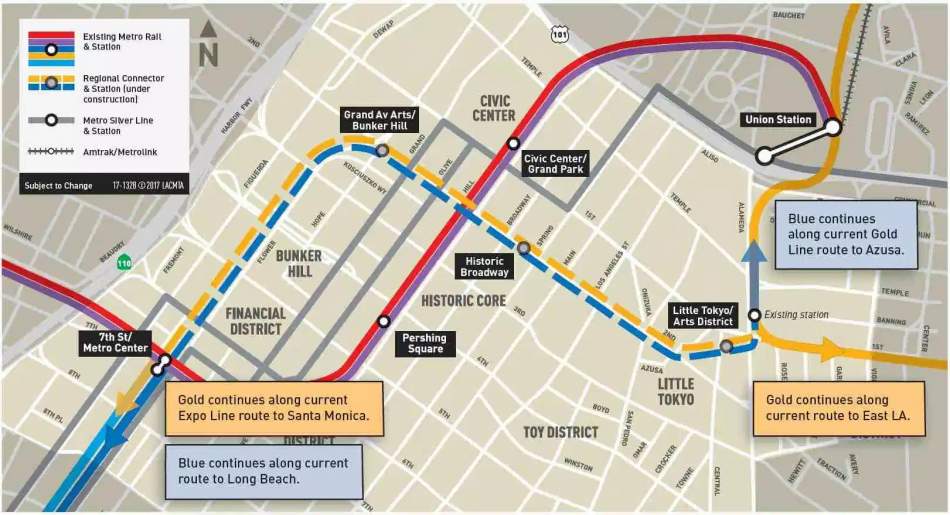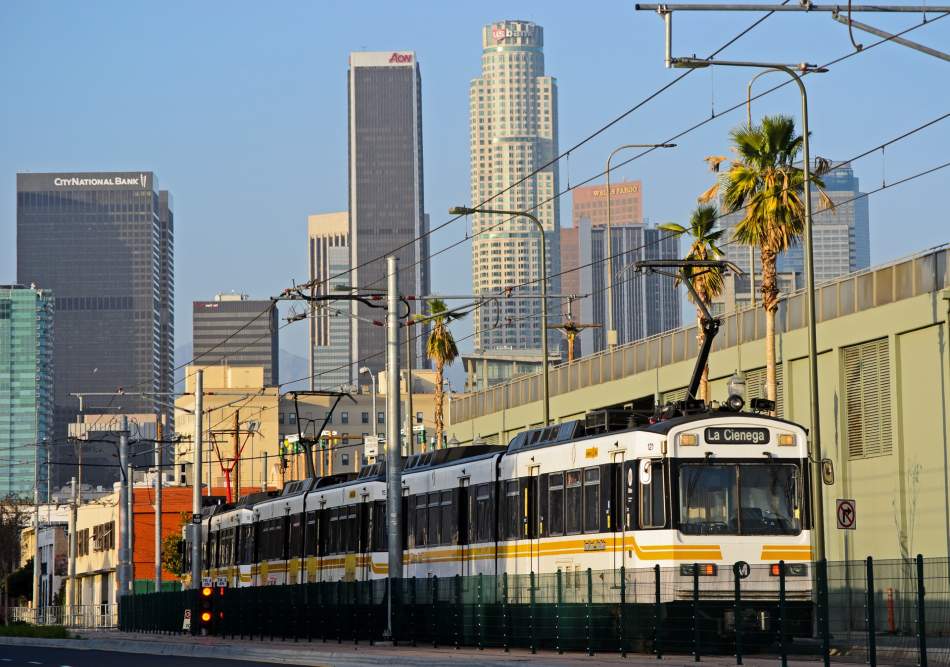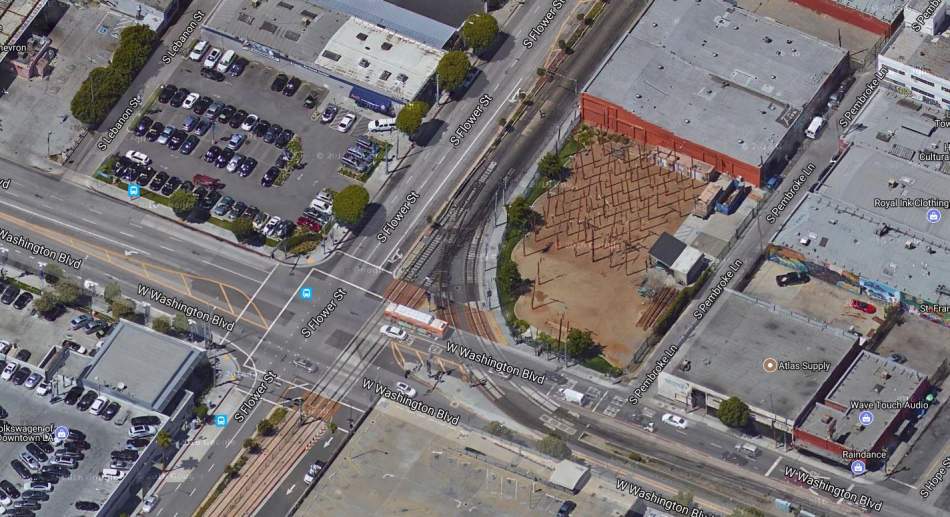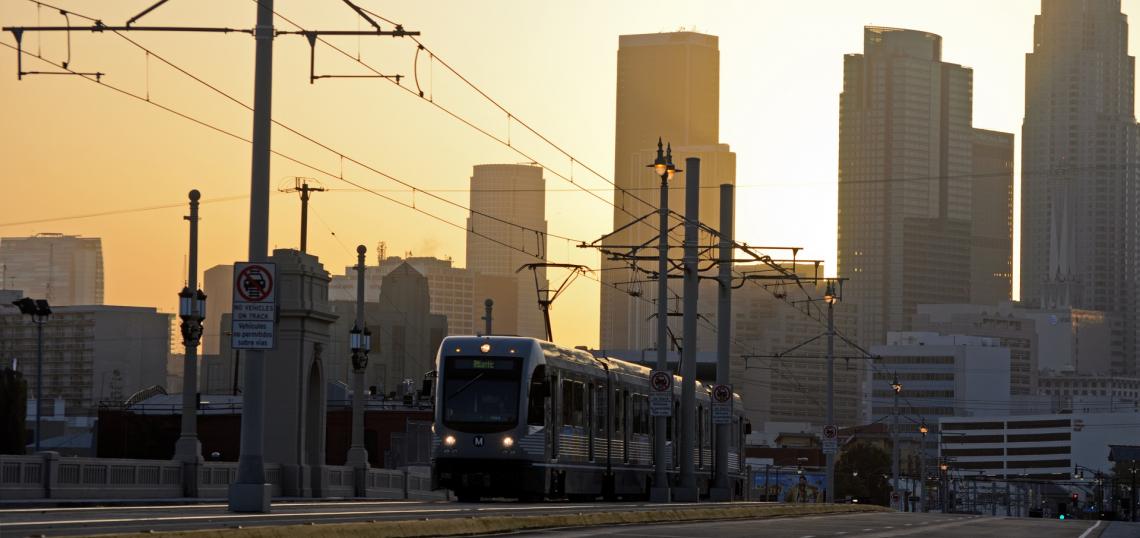Last year, with the goal of ensuring consistent service intervals on the new Regional Connector subway in Downtown Los Angeles, Metro's Board of Director renewed efforts to reduce delays on the street-running segments of the A (Blue), E (Expo), and L (Gold) Lines. A staff report filed last week to the Board's Operations Committee offers a sneak peak of what steps are being taken to reduce delays at street crossings, and sheds light on when changes may be rolled out across the system.
 Map of the Regional Connector tunnel, which will connect the A and E Lines with the L LineMetro
Map of the Regional Connector tunnel, which will connect the A and E Lines with the L LineMetro
Past studies of the at-grade segments of the A and E Lines within the City of Los Angeles have found that trains operate well below the designated street-running speed of 33 miles per hour. A Line vehicles along Washington Boulevard run at speeds ranging between 22 and 26 miles per hour, while trains along Flower Street are operate at speeds as low as 10 miles per hour.
Inconsistent service on the E Line - which operates mostly at street-level between Downtown Los Angeles and Santa Monica - has previously motivated Metro and the Los Angeles Department of Transportation (LADOT) to address delays at some of its at-grade crossings. Modifications to signal timing recently implemented at the intersection of Exposition Boulevard and Normandie Avenue reduced average delays from 27 seconds to 17 seconds. The modified timing allowed trains to cross Normandie without stopping 79 percent of the time - up from 58 percent prior to the changes.
The width of some of the streets on which the trains run - specifically Exposition, Washington, and Flower - also pose challenges according to the staff report. Wider streets, in addition to encouraging faster vehicle traffic, also require additional time for pedestrian clearance at crosswalks, increasing delays for light rail vehicles.
 An E Line train running north on Flower Street toward Downtown Los AngelesWikimedia Commons
An E Line train running north on Flower Street toward Downtown Los AngelesWikimedia Commons
"For example, the street width crossing E Line (Expo) at Vermont Ave in Los Angeles is about 43 feet greater than at Lincoln Boulevard in Santa Monica," reads the staff report. "[This] translates to at least 12 additional seconds of time assigned that cannot be allocated to train movement."
Metro is planning to equip certain trains on the A and E Lines with GPS units to study red light delays, station dwell times, and trip times through Summer 2021. The transportation agency would then work in coordination with LADOT to implement solutions to improve service reliability - including pilot signal phasing improvements - in Fall 2021.
Outside of adjusting the timing of traffic signals, two other options are also under consideration.
Per the staff report, Metro is considering raising maximum speeds along non street-running segments of the A, E, and L Lines from 55 miles per hour to 65 miles per hour. This would amount to a time savings of 10 second per mile, or as much as 14 seconds per mile if speed limits were raised to 70 miles per hour. However, increased speeds would require modifications to track circuits and onboard equipment, and the staff report notes that additional study would be required to determine if it is a feasible option.

The most costly option on the table is a proposed grade separation project which would partially segregate the Washington Boulevard - Flower Street wye - where the A and E Lines intersect - from vehicle and pedestrian cross-traffic. However, funding for such a project does not yet exist, and cost estimates for three alternatives identified by staff range from as low as $330 million to as high as $840 million.
Without a clear means to realize a grade separation project, Metro staff intend to once again coordinate with LADOT on lower-cost alternatives, such as restricting certain traffic approaches to the Washington-Flower intersection and redirecting automobiles toward different corridors.
- Another Push to Speed Up Metro's Street-Running Light Rail Lines (Urbanize LA)
- L.A. City Council Votes to Improve E Line Signal Priority (Urbanize LA)
- Looking at Metro's Options for Fixing Flower Street (Urbanize LA)






